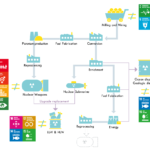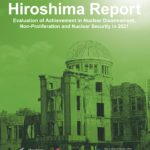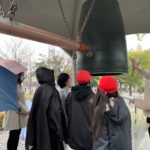III Toward the Realization of the Project
In 1948, the project started to move toward realization. Just after the end of the war, Schmoe had sought permission to go to Japan in order to conduct a relief project and finally gained permission in the summer three years after the atomic bombing. Since it was unable to obtain permission as individual relief activity, he joined LARA10. LARA is an abbreviation for the Licensed Agencies for Relief Asia, created in 1946 by several organizations including American Friends Service Committee, both Catholic and Protestant groups for the purpose of engaging in aid relief activities. A variety of goods such as food, clothing, medicine from individuals, groups, and countries such as the United States, Canada, Argentina and Peru, were shipped to Yokohama Port. The commodities were sent to each prefecture based on the allocation decided by the LARA central committee and the Ministry of Health and Welfare (present Ministry of Health, Labor and Welfare11). Hiroshima and Nagasaki, which were devastated by the atomic bombings, were considered in need of urgent aid compared to large cities such as Tokyo and Osaka, and they received relief packages from the beginning of LARA activity in 194612. Honkawa Elementary School in Hiroshima possesses photos of children who were delighted to receive clothing from LARA. The clothing was sometimes reformed for Japanese people. Relief activities by LARA continued until 1952, and by March 31 of that year, approximately 16,000 tones had been sent, benefiting more than one million people.13
Schmoe delivered food and clothing to hospitals and orphanages.14 As part of the Heifers for Relief project, he brought goats from the United States when he came to Japan15. By the end of 1949, the Heifers for Relief project had delivered nearly 2000 goats and more than 70 cows to Japan for milk supplies and the development of farming.16
Not only engaging in relief activities, Schmoe visited Hiroshima and explained the Houses for Hiroshima project to stakeholders. While explaining, he felt that he could gain support from them, including from the Mayor of Hiroshima17. The document recorded that the Mayor of Hiroshima City, Governor of Hiroshima Prefecture and occupation military authorities promised cooperation in the project18. Schmoe also inspected Hiroshima City.
The city was devastated by the atomic bomb and 90% of buildings in the city were damaged19 and many people were killed. The survivors had to collect tins and wasted materials from the devastated city to build temporary barracks on their own. A report says that as of August 1946, about 12,000 homes out of 37,000 were such barracks. 20 Among problems of food, clothing and houses, the housing shortage continued even after the other two problems began to improve.
In a city report in 1949, when Schmoe started housing construction in Hiroshima, a shortage of 16,000 houses was predicted. In April, they discussed how to deal with the housing problem at a public meeting hosted by Hiroshima City21. The housing supply was an urgent problem. Since it was the first time for him to build Japanese-style houses, Schmoe carefully observed the Japanese building style22. He made a solid foundation for the implementation of the project. After returning to the United States, Schmoe started preparation for housing construction in Hiroshima. He started with fundraising. In a document calling for donations, he aimed at 4,000 dollars. He allocated 3,000 dollars for purchasing materials in Japan and the remaining 1,000 dollars for travel expenses from the United States. He planned to extend the fundraising over a period of four months rather than collecting all the money at once. The document also included talks with Japanese supporters such as the governor of Hiroshima Prefecture and the mayor of Hiroshima City23. Support was also provided by the Pacific Friends Service Committee and the Japan Friends Service Committee, which had strong ties with Schmoe. However, in fundraising, Schmoe himself played the pivotal role. He wrote to his friends to whom he had sent Christmas cards every year to ask for donations24. Finally, exceeding the target of 4,000 dollars, 4,300 dollars were donated from almost all the states in the U.S, Alaska and Hawaii (at that time, not yet part of the United States), Mexico, Canada, France, Puerto Rico, China and Japan25. In 1949, 4,300 dollars was equivalent to 1,548,000 yen. The average monthly salary was 6,902 yen (August 1949) 26.
As members going to Hiroshima to build houses, Emery Andrews, Daisy Tibbs, and Ruth Jenkins were selected, along with Schmoe himself. All three of the other members had been engaged in support activities for Japanese Americans during World War II. Andrews was a pastor of the Japanese Baptist Church in Seattle, Washington, and was one year older than Schmoe. Since Schmoe trusted him, having worked together during the war, Andrews had been the first person who came to mind when Schmoe had planned the House for Hiroshima project. Andrews fundraised 700 dollars for expenses to visit Hiroshima27. Also, Andrews took the lead in a 1951 Hiroshima visit which Schmoe did not take part in.
Daisy Tibbs was a black woman and a faculty member of Harbinson Junior College, South Carolina. On receiving a Christmas card calling for participation in the Houses for Hiroshima project from Schmoe, she related, “I was perplexed and hesitated at this unrealistic project, but finally agreed to go to Hiroshima” 28. Ruth Jenkins was tall, red-haired woman who taught at an elementary school in Arizona, the United States. She also participated in a Friends Service Committee project in Europe29.
In order to obtain permission from the occupation army to enter Japan, Schmoe advised these three members on how to write application forms, for example, mentioning that they would stay in Japan as part of the Friends Service Committee project for four months30. As a result, in case of Andrews, on July 5, 1949, he was permitted to visit Japan for two months from July 31 to September 30 for missionary purposes31.
For a smooth implementation of the project in Hiroshima, they exchanged several letters with both Hiroshima Prefecture and City to proceed in negotiations. In a letter to Schmoe written on April, 5, the general manager of the General Affairs Division, Hiroshima Prefecture, wrote that both Hiroshima Prefecture and City appreciated the offer of support and that they would cooperate with Schmoe to realize the housing reconstruction project. In addition, the general manager understood that this project was designed not only for material support of reconstruction, but also to rebuild the relationship between America and Japan32. As the project proceeded, Hiroshima Prefecture and City proposed the construction of children’s libraries instead of houses. In Hiroshima, because more than 10,000 people needed houses and only a few people would be able to live in the houses that Schmoe would build, a public project was deemed more expedient33. In response to this proposal, Schmoe wrote in a letter to Hiroshima mayor Hamai, on June 30, that he understood and accepted the proposal. Also, in the letter, he explained that he planned to build a 15-tsubo (about 50 m²) building and would bring materials such as glass and nails for sliding doors, copper pipes for plumbing, and copper wires for electricity, but wood would be purchased in Hiroshima. He also asked to order wood ahead of time to proceed with the construction on schedule because it would take time to dry the wood. He also mentioned the date of his arrival to Japan34.
Their project in Hiroshima was beginning.
10 Floyd Schmoe, “A HOUSE FOR HIROSHIMA”Floyd W. Schmoe Papers, 1903-1993 University of Washington Libraries, Special Collections Accession No.0496-008 Box12 Folder 1
11 Eiji Takemae and Takamura Nakamura(supervised), Takashi Suganuma (ed.),History of the non-military activities of the occupation of Japan vol.23 Social Welfare, Nihontokyo Center, 1998, pp115-118
12 Japan National Council of Social Welfare. LARA Kinenshi (LARA Memorial Magazine), 1996
13 Japan National Council of Social Welfare. LARA Kinenshi (LARA Memorial Magazine), 1996年
14 Floyd Schmoe, “A HOUSE FOR HIROSHIMA”Floyd W. Schmoe Papers, 1903-1993 University of Washington Libraries, Special Collections Accession No.0496-008 Box12 Folder 1
15 Ferner Nuhn“, HE WANTED TO BUILD HOUSES FOR HIROSHIMA” FloydW.SchmoePapers, 1903-1993 University of Washington Libraries, Special Collections Accession No.0496-008 Box 13 Folder 1
According to this material, Schmoe surprisingly brought 250 goats to Japan.
16 Eiji Takemae and Takamura Nakamura (supervised), Takashi Suganuma (ed.),History of the non-military activities of the occupation of Japan vol.23 Social Welfare, Nihontokyo Center, 1998, pp118
17 Letter from Floyd Schmoe to Emery Andrews January 24, 1949 Emery E. Andrews papers, 1925-1959 University of Washington Libraries, Special Collections Accession No.1908-001 Box 1 Folder 15
18 Alice Franklin Bryant “A HOUSE FOR HIROSHIMA”May 20, 1951 Floyd W. Schmoe Papers, 1903-1993 University of Washington Libraries, Special Collections Accession No.0496-008 Box13 Folder 9
19 Hiroshima City, Shouwa 21Nendo Hiroshimashi Shisei Gaiyou (1946 City Guide of Hiroshima), 1946, pp57-58
20 Hiroshima City (ed.), Hiroshima Shinshi Shimin Seikatsuhen (NewHiroshimaHistory:CivicLife),1983, pp56
21 Hiroshima City (ed.), Hiroshima Shinshi Shimin Seikatsuhen (New Hiroshima History: Civic Life),1983, pp60
22 Letter from Floyd Schmoe to “Pinky.”January 9, 1949 Emery E. Andrews papers, 1925-1959 University of Washington Libraries, Special Collections Accession No.1908-001 Box 1 Folder 15
23 Fund-raising document for the Houses for Hiroshima Plan Emery E. Andrews papers, 1925-1959 University of Washington Libraries, Special Collections Accession No.1908-001 Box 4 Folder 8
24 Floyd Schmoe interview, 1989 Collection of American Friends Service Commitee
25 Letter from Floyd Schmoe to Miss Thompson September 14, 1949 Floyd W. Schmoe Papers, 1903-1993 University of Washington Libraries, Special Collections Accession No.0496-008 Box12 Folder 16
26 Hiroshima City, Shouwa 24 Nendo Hiroshimashi Shisei Gaiyou (1949 City Guide of Hiroshima),1946, pp78
27 Letter from Floyd Schmoe to friends April 23, 1949 Emery E. Andrews papers, 1925-1959 University of Washington Libraries, Special Collections Accession No.1908-001 Box 4 Folder 8
28 Testimony of Daisy Tibbs, 2012, People engaged in exhibition of Houses for Hiroshima at Schmoe House
29 Letter from Floyd Schmoe to gang June 10, 1949 Emery E. Andrews papers, 1925-1959 University of Washington Libraries, Special Collections Accession No.1908-001 Box 4 Folder 8
30 Letter from Floyd Schmoe to gang June 10, 1949 Emery E. Andrews papers, 1925-1959 University of Washington Libraries, Special Collections Accession No.1908-001 Box 4 Folder 8
31 “Emery E. Andrews Diary”, donated by Brooks Andrews, owned by the Hiroshima Peace Memorial Museum
32 Letter from Floyd Schmoe to Yoshinobu Kono Chief, General Affairs Dept., Hiroshima Prefectural Office April 5, 1949 Floyd W. Schmoe Papers, 1903-1993 University of Washington Libraries, Special Collections Accession No.0496-008 Box12 Folder 7
33 Letter from to Floyd Schmoe June 20, 1949 Floyd W. Schmoe Papers, 1903-1993 University of Washington Libraries, Special Collections Accession No.0496-008 Box12 Folder 7
34 Letter from Floyd Schmoe to Shinzo Hamai Mayor, Hiroshima City June 30, 1949 Floyd W. Schmoe Papers, 1903-1993 University of Washington Libraries, Special Collections Accession No.0496-008 Box12 Folder 7
Tags associated with this article







